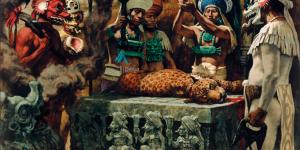You are here
Book of Mormon Central is in the process of migrating to our new Scripture Central website.
We ask for your patience during this transition. Over the coming weeks, all pages of bookofmormoncentral.org will be redirected to their corresponding page on scripturecentral.org, resulting in minimal disruption.
Gospel Doctrine Lesson #28: The Word Is In Christ Unto Salvation

Scripture Block
Alma 32-34
To help class members understand that the word of God will lead them to Jesus Christ and to encourage them to “nourish the word” in their hearts (Alma 32:40).
Lesson Manual
KnoWhys

What Are the Nephite Articles of Faith?
Alma 33:22
Multimedia
Video: BYUtv Discussions on the Book of Mormon: Alma 33-35. Available at BYUtv.org
Video: Interpreter Scripture Roundtable: Book of Mormon Gospel Doctrine 28.
Image: Zoram by James Fullmer.
Chart 36: "Nephihah as Chief Judge: Years 9-24 of the Reign of the Judges" from Charting the Book of Mormon.
Chart 42: "Nephite Declaration of Faith" from Charting the Book of Mormon.
Chart 43: "Consistent Elements in Nephite Declarations of Faith" from Charting the Book of Mormon.
Chart 95: "Three Trees in the Book of Mormon" from Charting the Book of Mormon.
Chart 145: "Nephite Cycles: Years 1-49 of the Reign of the Judges" from Charting the Book of Mormon.
Articles
Alma 32
David E. Bokovoy, "The Word and the Seed: The Theological Use of Biblical Creation in Alma 32," Journal of Book of Mormon Studies 23 (2014): 1-21.
Alma 32 is a learned text on the topic of faith. The account incorporates creation imagery from the opening chapters of Genesis. Alma’s sermon follows a theological pattern in the Hebrew Bible where creation is used to encourage audiences to exercise
faith in the present by considering the primordial past.Alma compares the “word of God” unto a seed, telling his audience that they are to be involved with “planting.” Thus, Alma’s sermon combines the two distinct creation views in the Genesis narratives, for God speaks the divine word in order to create in Genesis 1, and he plants seeds and trees to create his garden paradise in Genesis 2–3. By invoking the miracle of creation in the past into a present context of seed growth and recreation, Alma encourages his readers to fulfill the measure of their own creation by experimenting upon the divine word. Obtaining the type of faith Alma describes is therefore the very purpose of human existence, and it has been from the beginning.
Adam S. Miller, ed. An Experiment on the Word: Reading Alma 32 (Provo, UT: Neal A. Maxwell Institute for Religious Scholarship, 2014).
In this collection of essays, six scholars theologically examine Alma chapter 32 in the Book of Mormon, which contains some of the most insightful verses about faith in the entire Latter-day Saint canon. Not only do these scholars shed new light on Alma 32, they also provide exemplary models for improved scripture study more generally.
Joseph Thomas Hepworth, “Watermelons, Alma 32, and the Experimental Method,” BYU Studies 23, no. 4 (Fall 1983): 497–501.
This short essay compares the cultivation of watermelons and Alma 32. The author expresses his own experience with growing watermelons to expound on the teachings found in Alma 32 on faith.
Elaine Shaw Sorensen, “Seeds of Faith: A Follower’s View of Alma 32,” in The Book of Mormon: Alma, the Testimony of the Word, ed. Monte S. Nyman and Charles D. Tate Jr. (Provo, UT: Religious Studies Center, Brigham Young University, 1992), 129–39.
In a more devotional approach, Sorenson discusses the doctrines that Alma teaches about faith. The beauty of Alma's message is preserved in Mormon's abridgement through the metaphor of the planting and nourishing of the seed of God's word.
Virginia H. Pearce, “Trying the Word of God,” Ensign, May 1995, online at lds.org
In an address from 1995, Virginia Pearce expounds on the doctrine of faith found in Alma 32. Alma's metaphor of the seed creates a vivid image for those learning about the nature of faith.
Larry E. Dahl, "Faith, Hope, and Charity," in The Book of Mormon: The Keystone Scripture (Provo, UT: BYU Religious Studies Center, 1988).
In an article on the three virtues found in the last chapter of Moroni, Dahl uses Alma 32 in his exposition on the doctrine of faith. Not only does Alma 32 provide clear definitions of the doctrine of faith, but it provides valuable insight in how one can develop faith throughout one's life.
Alma 33
Kristian S. Heal, "Look to God and Live," Insights 26, no. 2 (2006).
Kristian Heal points out that the story of Moses and the brazen serprent comes up in the Book of Mormon several times. However, in 1 Nephi 17 and Alma 33, the story is expanded from what we read in the King James Bible. It is from Alma 33 that we learn that those that did not look at the serpent did indeed perish.
Paul Y. Hoskisson, "Jeremiah's Game," Insights 30, no. 1 (2010).
Hoskisson explains the Hebrew game called atbash and how it is used to craft literary devices. He uses this understanding to approach Alma 14 and 33 in a new light. Namely, Hoskisson proposes that because of the potential Hebrew literary device, instances of the word "records" may refer to copies of the holy scriptures.
Daniel H. Ludlow, "Zenos," To All the World: The Book of Mormon Articles from the Encyclopedia of Mormonism. Edited by Daniel H. Ludlow, Paul Y. Hoskisson, and John W. Welch (Provo, UT: FARMS, 2000).
In Alma 33, Alma and Amulek refer to the prophet Zenos in their preachings. This article is an encyclopedic entry on what is known about the elusive Biblical prophet Zenos.
Royal Skousen, "Book of Mormon Critical Text Project Continues with New Volume," Insights 27, no. 4 (2007).
Skousen points out a significant variant in the text of the Book of Mormon in Alma 33:21. Where the verse reads "healed" it should read "behold" in the Original Manuscript, referring to the brazen serpent in Deuteronomy.
Alma 34
John A. Tvedtnes and Matthew Roper, "Scriptural Insight: Do Not Procrastinate the Day of Your Repentance," Insights 20, no. 10 (2000).
Alma 34:32-34 explains that one ought not to procrastinate the day of one's repentance. While this seems to contradict the doctrine that one can still accept the gospel of Jesus Christ in the world to come Tvedtnes and Roper provide an insightful reading of the passage to clarify the seeming contradiction.
John Gee, "Book of Mormon Word Usage: 'Seal You His,'" Insights 22, no. 1 (2002).
The peculiar phrase "seal you his" is found in Alma 34:35 and seems to be grammatically awkward, as the verb "to seal" does not usually take a possessive personal pronoun as its direct object. John Gee provides an ancient Near Eastern perspective that may help to illuminate the phrase's original meaning in light of ancient Mesopotamian seals.
Mark A. Wright and Brant A. Gardiner, "The Cultural Context of Nephite Apostasy," Interpreter: A Journal of Mormon Scripture 1 (2012): 25-55.
In Alma 34 we see the repercussions of the Zoramite dissensions. Nephite apostates turned away from true worship in consistent and predictable ways throughout the Book of Mormon. A Mesoamerican setting provides a plausible cultural background that explains why Nephite apostasy took the particular form it did and may help us gain a deeper understanding of some specific references that Nephite prophets used when combating that apostasy. Wright and Gardiner propose that apostate Nephite religion resulted from the syncretization of certain beliefs and practices from normative Nephite religion with those attested in ancient Mesoamerica.
Alma 35
Parrish Brady and Shon Hopkin, "The Zoramites and Costly Apparel: Symbolism and Irony," Journal of Book of Mormon Studies 22, no. 1 (2013): 40-53.
The Zoramite narratives of Alma 31–35 and Alma 43–44 are richly symbolic accounts woven with many subtle details regarding the importance of costly apparel and riches as an outward evidence of pride. This literary analysis focuses on how Mormon as editor structured the Zoramite narrative and used clothing as a metaphor to show the dangers of pride and the blessings afforded by humble adherence to God’s teachings and covenants.
Gordan C. Thomasson and John W. Welch, "The Sons of the Passover," in Reexploring the Book of Mormon: A Decade of New Research (Provo, UT: FARMS, 1992).
This article explores the ancient Jewish tradition at Passover that seems to find resonance in Alma's discourses to his various sons. At Passover, there is a tradition that the sons would ask the father separate questions to which the father would respond. These questions find somewhat of a correspondence with the questions asked by Alma's sons in Alma 35-39.
"Zoram," in the BYU Onomasticon.
An etymology of the name "Zoram".
"Zoramite(s)," in the BYU Onomasticon.
An etymology of the name "Zoramites".
Matthew L. Bowen, "'See That Ye Are Not Lifted Up': The Name Zoram and its Paranomastic Perjuration," Interpreter: A Journal of Mormon Scripture 19 (2016): 109-143.
The most likely etymology for the name Zoram derives from the Hebrew, meaning, “He [God] has poured forth in floods.” However, the name could also have been heard and interpreted as something like “the one who is high,” “the one who is exalted” or even “the person of the Exalted One [or high place].” This article examines the various etymology possibilities, and provides commentary on its implications for the rest of the narrative. If Zoram carries meaning of being high or exalted, then the Zoramites and their apostasy may represent a type of Latter-day Gentile pride and apostasy, which Nephi, Mormon, and Moroni took great pains to warn against.
Additional Lesson Guides
RSC Gospel Doctrine Lesson #28
LDS Living Gospel Doctrine Lesson #28
Meridian Magazine Gospel Doctrine Lesson #28
Ben Spackman on Patheos Lesson #28
Joel's Monastery Blog on Gospel Doctrine Lesson #28
GospelDoctrine.com Alma 32, Alma 33, Alma 34, Alma 35


